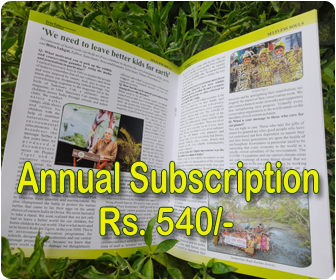Looking at the times we live in, somehow, we have to co-exist with other living creatures, be it dogs, cats, monkeys, elephants or tigers! Hence, there are bound to be conflicts too, just like the conflicts that occur among neighbours or communities, but that need not stop us from existing together. Wherever the man is encroaching (or interlinking) upon the land of the wild, stress erupts from tigers, leopard or elephants; whereas, wherever the wild is forced to invade human settlements (mostly in urban areas), tension is caused by dogs, cows or monkeys. The need of the hour is to learn how to manage this situation rather than to try and make one party vanish completely. Where a human life is concerned, other life forms hold no value- but this is wrong. It is against the law of nature and causes a biospheric imbalance whose impact is felt by the human race in the long run. We need to move from seeing humanity as separate from and superior to nature, and recognise the interconnectedness that means we are part of nature.
The expansion of our cities and towns often results in negative human-animal conflict. Urban sprawl creates new homes for some animals, even as it displaces others. The results are often problematic. Urban nature conservation generally should aim to retain existing wildlife habitat by incorporating biodiversity conservation into urban planning and land development. New societies should be planned this way, while existing ones should be given more open spaces and green patches. It also means understanding animal behaviour and taking precautions to avoid conflicts. For example, to effectively coexist with street dogs in urban areas, it is crucial to prioritise their well-being and manage interactions responsibly. This involves promoting vaccination and sterilisation programmes, establishing designated feeding areas, and fostering community involvement through education and responsible pet ownership. Additionally, understanding dog behaviour and practising safe interaction techniques can minimise conflicts. Proper waste management is crucial to prevent attracting dogs and other animals to areas where they can be a nuisance or pose a health risk.
Do not provoke, tease, or corner street dogs. Avoid prolonged eye contact, sudden movements, or loud noises. Maintain a safe distance from dogs, especially when they are eating or sleeping. If a dog approaches you, remain calm and slowly back away. Learn to recognise signs of aggression or fear in dogs, such as growling, snarling, or stiff body posture. Above all, never let your kids roam alone on deserted streets or lanes during the night or even during the day. Make sure you go on night or very early morning walks in groups. If a bite occurs, get the person vaccinated for rabies and tetanus, even if the animal happens to be vaccinated. Raise awareness about street dogs and encourage empathy and understanding. Report any incidents of dog/monkey bites or aggression to the relevant authorities so that timely isolation and treatment of the animal can be done. Advocate for urban planning that considers the needs of all living beings, including street dogs. Addressing the stray problem in cities requires a coordinated effort between local governments, animal welfare organisations, and community members. By implementing a combination of education, proactive measures, and community involvement, cities can effectively manage stray animal populations, including dogs, while ensuring the safety and well-being of both animals and humans.
















Leave a comment